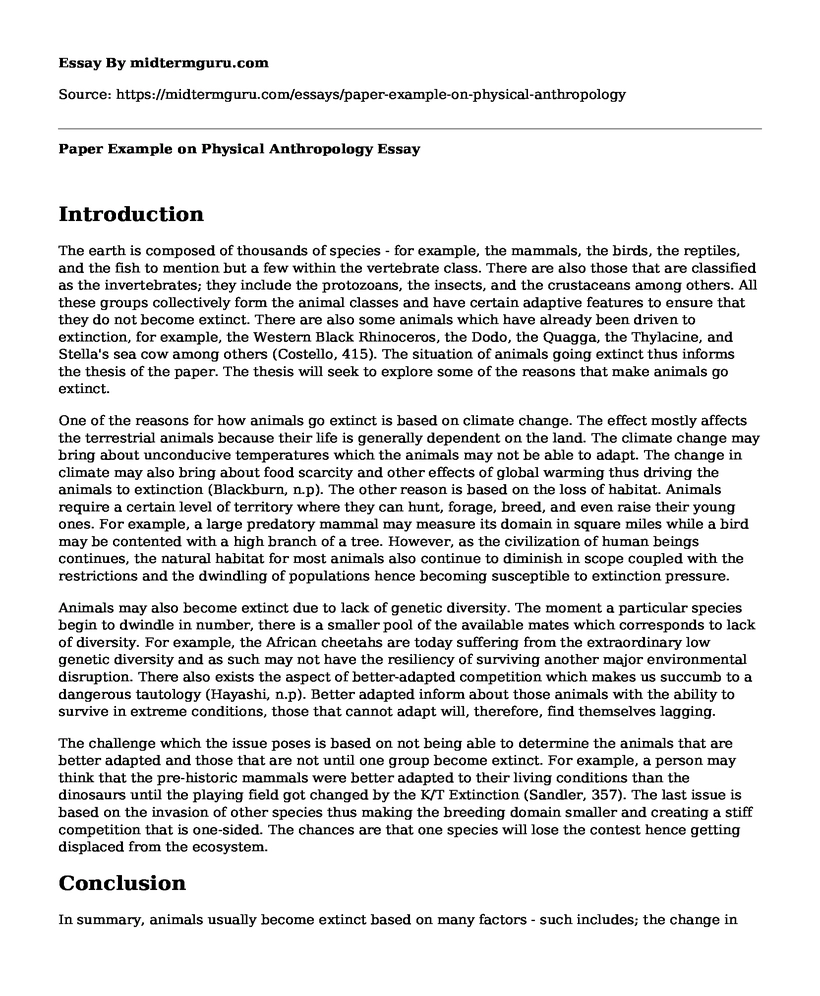Introduction
The earth is composed of thousands of species - for example, the mammals, the birds, the reptiles, and the fish to mention but a few within the vertebrate class. There are also those that are classified as the invertebrates; they include the protozoans, the insects, and the crustaceans among others. All these groups collectively form the animal classes and have certain adaptive features to ensure that they do not become extinct. There are also some animals which have already been driven to extinction, for example, the Western Black Rhinoceros, the Dodo, the Quagga, the Thylacine, and Stella's sea cow among others (Costello, 415). The situation of animals going extinct thus informs the thesis of the paper. The thesis will seek to explore some of the reasons that make animals go extinct.
One of the reasons for how animals go extinct is based on climate change. The effect mostly affects the terrestrial animals because their life is generally dependent on the land. The climate change may bring about unconducive temperatures which the animals may not be able to adapt. The change in climate may also bring about food scarcity and other effects of global warming thus driving the animals to extinction (Blackburn, n.p). The other reason is based on the loss of habitat. Animals require a certain level of territory where they can hunt, forage, breed, and even raise their young ones. For example, a large predatory mammal may measure its domain in square miles while a bird may be contented with a high branch of a tree. However, as the civilization of human beings continues, the natural habitat for most animals also continue to diminish in scope coupled with the restrictions and the dwindling of populations hence becoming susceptible to extinction pressure.
Animals may also become extinct due to lack of genetic diversity. The moment a particular species begin to dwindle in number, there is a smaller pool of the available mates which corresponds to lack of diversity. For example, the African cheetahs are today suffering from the extraordinary low genetic diversity and as such may not have the resiliency of surviving another major environmental disruption. There also exists the aspect of better-adapted competition which makes us succumb to a dangerous tautology (Hayashi, n.p). Better adapted inform about those animals with the ability to survive in extreme conditions, those that cannot adapt will, therefore, find themselves lagging.
The challenge which the issue poses is based on not being able to determine the animals that are better adapted and those that are not until one group become extinct. For example, a person may think that the pre-historic mammals were better adapted to their living conditions than the dinosaurs until the playing field got changed by the K/T Extinction (Sandler, 357). The last issue is based on the invasion of other species thus making the breeding domain smaller and creating a stiff competition that is one-sided. The chances are that one species will lose the contest hence getting displaced from the ecosystem.
Conclusion
In summary, animals usually become extinct based on many factors - such includes; the change in climate, invasion by other species, lack of habitat, the better-adapted competition, and lack of genetic diversity. The increase of human civilization may also pose a threat to the animals' population because human beings will invade the animals' environment with the aim of establishing a settlement. It is thus essential that we all consider the importance of animals and mitigate issues which may bring about their extinction. Human beings can control all the factors discussed in the body and are well placed in ensuring that animals remain safe and protected.
Works Cited
Blackburn, Tim M., Julie L. Lockwood, and Phillip Cassey. "The influence of numbers on invasion success." Molecular Ecology 24.9 (2015): 1942-1953.
Costello, Mark J., Robert M. May, and Nigel E. Stork. "Can we name Earth's species before they go extinct." science 339.6118 (2013): 413-416.
Hayashi, Stuart K. Hunting Down Social Darwinism: Will This Canard Go Extinct?. Lexington Books, 2015.
Sandler, Ronald. "The ethics of reviving long-extinct species." Conservation Biology 28.2 (2014): 354-360.
Cite this page
Paper Example on Physical Anthropology. (2022, Oct 20). Retrieved from https://midtermguru.com/essays/paper-example-on-physical-anthropology
If you are the original author of this essay and no longer wish to have it published on the midtermguru.com website, please click below to request its removal:
- SAT Math Problems With Solutions
- Paper Example on Ohm's Law
- Paper Example on Primate Intelligence Evolution
- The Homo Sapiens and Neanderthals - Essay Sample
- Space Exploration: A Journey Across the Moon - Research Paper
- Fire Dynamics Case Study
- Math Education: Field Experiences for Improvement - Research Paper







